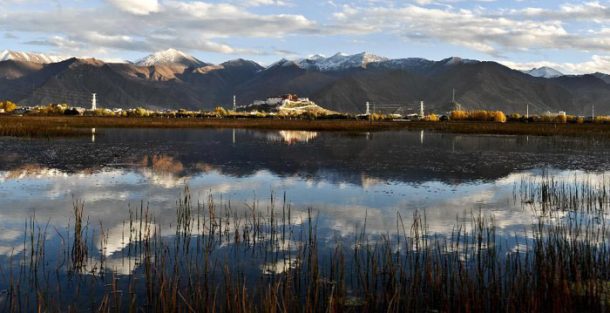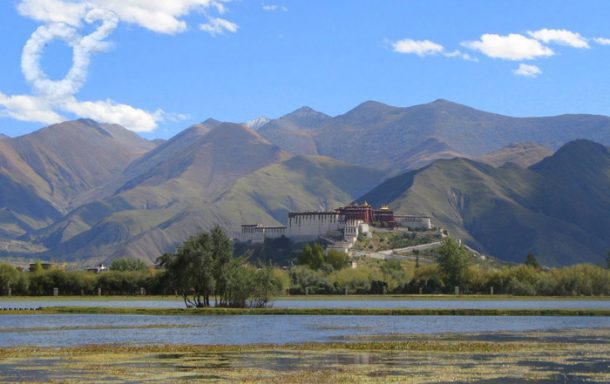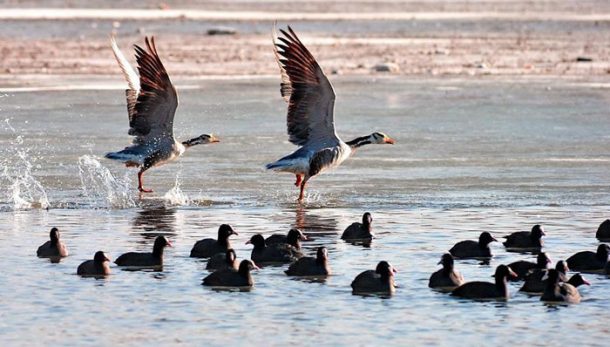Lalu Wetlands in Lhasa
Many of the tourists that come to this high-altitude region stay in Lhasa, experiencing the heartland of Tibet for a few days. And this city on the roof of the world is one of the most amazing on the planet, with a multitude of attractions to visit. It is more amazing than the spectacular Lalu Wetlands of Lhasa.

The highest and largest urban wetland in the world, this tranquil place is one of the most important areas of the Tibetan capital. Any visitor to Lhasa that does not get to visit this attraction is missing out on one of the most special sights on the plateau.
Known as the “Lung of Lhasa”, the Lalu Wetlands are located to the west of Lhasa, on the edge of the city. Stretching for around 12.2 square kilometers, this unique piece of land is an awesome life-source for migrating birds, wetland animals, and even the people of Lhasa.
Lying at an altitude of around 3,646 meters above sea level, the wetlands are the main oxygen-producing area around Lhasa and provide the much-needed moisture and additional oxygen content in the air that makes Lhasa a more comfortable place to visit.
Table of Contents
Best Time to Visit Lalu Wetlands
The Best Time of Year
Visiting the wetlands depends on what you are looking for and why you are visiting. If you are just interested in the stunning natural landscape of the wetlands, then you can travel there all year round. The different seasons offer different attractions to the area, with the beauty of the summer rains and sunshine making the area warm and humid, while the winter has a little frosty coating on the wetlands in the morning, making it an amazing sight and a great photo to remember it with.
For those that are interested in bird watching at the wetlands, the summer or winter are the best times of the year to visit. Really, there are birds on the wetlands all year round, whether local birds or migratory birds from the north of Tibet. The local birds are best seen in the summer months, from June to September, once the fledglings have left the nest and started flying and feeding themselves. The flocks of local wild birds are astounding to see in the summer months.

The winter months, from November to March, are the time of the migratory birds on the wetlands, and this is the best time for bird watching if you are interested in the species of birds that travel south for the winter. Lhasa is a lot warmer than northern Tibet in the winter months, and a number of migratory species travel south in November to their winter feeding grounds on the wetlands.
The Best Time of Day
Birds are creatures that move at certain times of the day, and through most of the day, you may not see the numbers of birds that you might expect. This is due to the fact that these migratory birds are here to find food for the winter season, and fly far and wide to forage for food on the plateau, some traveling as much as 30 kilometers a day to forage for decent food sources.
For the best opportunities to see the migratory birds on the wetlands, you need to be there in the early morning, just after dawn, when the birds will fly off to forage, or in the evening, around dusk, when the foraging birds are returning to roost for the night. However, while dusk can give you some excellent mood shots of the birds, the lighting is best after dawn in the morning, when the birds are most active, and as they fly off over the wetlands.
What Birds to See
The wetlands are a natural winter feeding and foraging ground for several species of migratory birds, including the Black-Necked Crane from northern Tibet, the Ruddy Shelduck, Bar-Headed Goose from Mongolia, White Storks from Qinghai, and a few other gulls and shanks that call the area home in the winter.
The wetlands are not the only place to go bird watching for such rare species as the Black-Necked Cranes. In the winter months, they can often be seen on the edges of Lake Yamdrok, to the southwest of Lhasa on the road to Gyantse. In the summer months, they are easily found in their summer habitats in the far north of Tibet, but also at Lake Namtso, in Damxung County, to the north of Lhasa.

If you are planning a bird watching a tour of Tibet, we have some excellent tours that can cater to your needs, such as the 6 Days Lhasa and Lake Namtso Small Group Tour and the 6 Days Eastern Lhasa Discovery Tour.
Tips for Bird-watching in Lalu Wetlands
Bird watching in Tibet is no different to any other country around the world, and while you may think that there are special equipments needed, there is nothing special needed for viewing the birds at Lalu Wetlands. The main gears you will need are camera with zoom and telephoto lenses, a good pair of binoculars, preferably with around a 30-70x zoom, and a tripod for those more stable shots.
The usual rules still apply when bird watching in Tibet, such as keeping a safe distance from the birds and their nests, not feeding the birds with food in order to attract them, using only natural light with no flash photography, and refrain from wearing bright or billowing clothes, as this can scare the birds, even from a distance.

However, that said, there are some special requirements for Tibet itself, even if bird watching is the same. The sunlight on the plateau can be harsh, and can be damaging to the skin. It is best to make sure that you have a good sun block for staying out in the sun all day, as well as moisturizers and lip balm for the chaffing winds, and a good hat to keep the bright sun off your head.
Cost of visiting Lalu Wetlands
Actually, there is no cost for visiting the wetlands at all. The Lalu Wetlands are divided into three parts, some of which can be accessed and some which are closed to tourists. The outer edges of the wetlands are open to anyone, and can be accessed easily from the surrounding roads, but only for a very short distance along the sides of the roads.
The inner edges between the outer and core areas are for educational purposes and are only accessible with a local permit for schools and colleges. The inner core of the wetlands is inaccessible to anyone except the park rangers, who oversee the protection and conservation of the area.
Recent Posts
The Ultimate Guide to Tibet Tours, Travel, and Trekking Adventures
How to Explore Tibetan Culture
Exploring Lhasa:The Heart of Tibet
All Categories
- About Tibet
- book a Tibet tour
- Buddhism Practice
- Budget Tour
- China-Tibet Train
- Customized Tibet tour
- Historical Sites
- Hot Springs in Tibet
- News
- Photography in Tibet
- Tibet attraction
- Tibet Group Visa
- Tibet Motorcycle Tour
- Tibet Small Group Tours
- Tibet Tours and Tibetan Tour Guide
- Tibet Train
- Tibet Travel FAQs
- Tibet Travel Information
- Tibet Travel News
- Tibet Travel Permit Update
- Tibet Travel Prices Rises
- Tibet Trek
- Tibet Trekking Tour
- Tibet weather and climate
- Tibet Wildlife animals
- Tibet Winter Tour
- Tibetan Buddhism
- Tibetan Cultural Features
- Tibetan Culture and Poeple
- Tibetan Festivals
- What to see in Tibet



